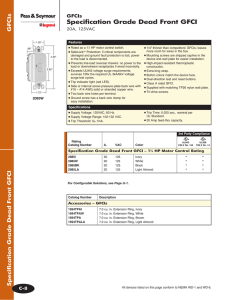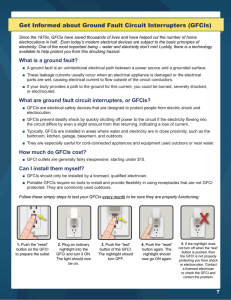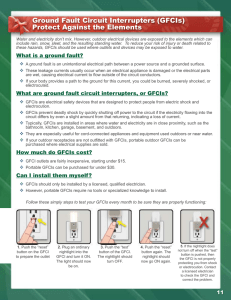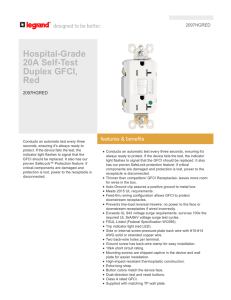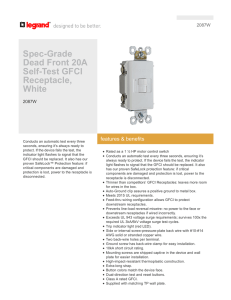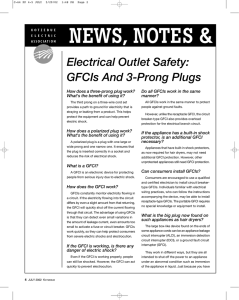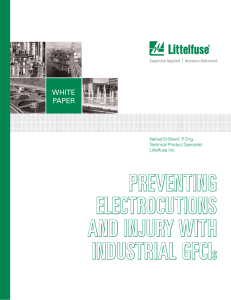Spring Electric Safety
advertisement
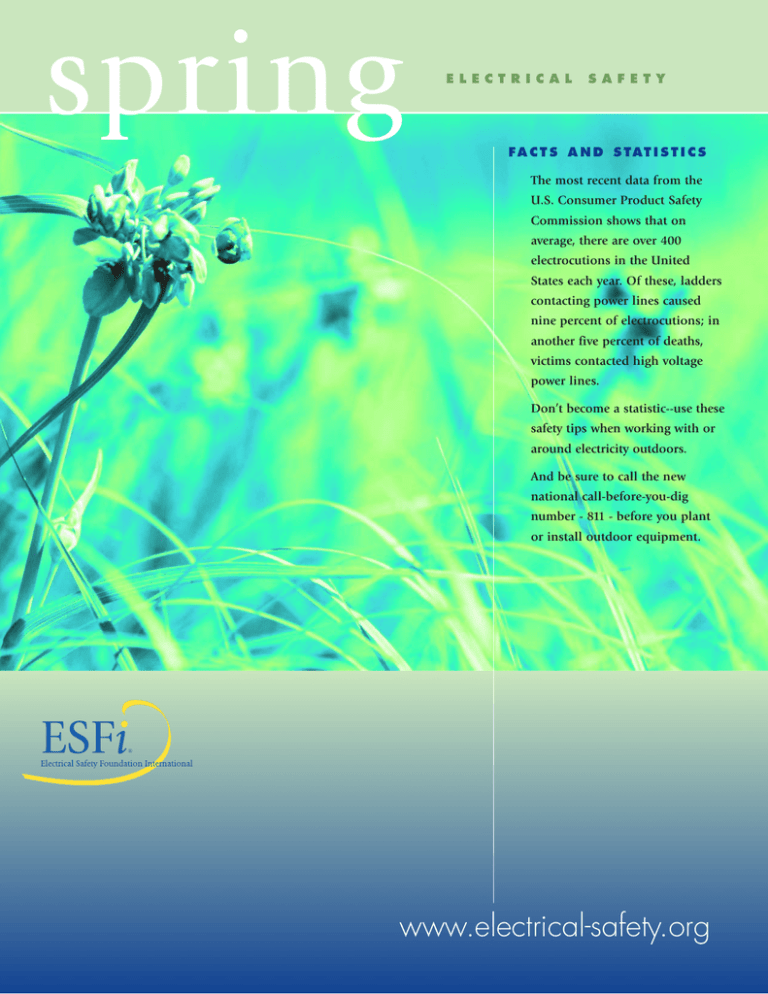
spring E L E C T R I C A L S A F E T Y F A C T S A N D S TAT I S T I C S The most recent data from the U.S. Consumer Product Safety Commission shows that on average, there are over 400 electrocutions in the United States each year. Of these, ladders contacting power lines caused nine percent of electrocutions; in another five percent of deaths, victims contacted high voltage power lines. Don’t become a statistic--use these safety tips when working with or around electricity outdoors. And be sure to call the new national call-before-you-dig number - 811 - before you plant or install outdoor equipment. www.electrical-safety.org OVERVIEW May is National Electrical Safety Month and a good time review electrical safety practices. Increasing electrical safety awareness, following electrical safety guidelines, and using tools and technology designed to address electrical hazards are all components of a safety program. The Electrical Safety Foundation International (ESFI) reminds those on the job to look up, look down, and look out for electrical safety hazards. POWER LINE SAFETY On average, 325 people die and 4,400 are injured each year because of electrical hazards, according to data published by the National Safety Council. Electricity ranks sixth among all causes of occupational fatalities. The leading cause of fatal electrical incidents while on the job is contact with power lines, both above and below ground. ESFI reminds homeowners and workers using ladders or scaffolds, and those carrying aluminum siding, poles, fencing and even lumber, to be aware and stay clear of power lines. Such contacts caused approximately 22 percent of the workrelated fatalities over a seven-year period, according to research (“Occupational Electrical Injuries in the US, 19921998,” published in the Journal of Safety Research ). Eliminating power line contacts with such equipment as cranes, boom trucks and dump trucks could reduce workplace electrical fatalities by another 17 percent annually, the study suggests. The study also notes that construction workers, who make up approximately 7 percent of the U.S. workforce, suffer 44 percent of the electrical fataities. Electrical safety experts suggest that the best insulator to keep workers safe from electricity is to stay at least 10 feet away from power lines. AV O I D O U T D O O R E L E C T R I C A L H A Z A R D S AT W O R K A N D H O M E Warmer weather brings an increase in outdoor work in many parts of the country, both on the job and at home. Increasing electrical safety awareness can help ensure those activities do not result in injuries and deaths, according to the Electrical Safety Foundation International (ESFI). ESFI notes that following safety rules can reduce electrical deaths and injuries: ✦ Ladders—even those made of wood—that contact a power line can prove fatal. ✦ Unplug outdoor tools and appliances when not in use. ✦ Inspect power tools and appliances for frayed cords, broken plugs and cracked or broken housing and repair or replace damaged items. ✦ Water does not mix with electricity. Avoid damp conditions — including wet grass — when using electricity. ✦ Wherever possible, use a portable ground fault circuit interrupter (GFCI) or purchase tools with built-in GFCI technology. For additional electrical safety information, visit the Electrical Safety Foundation International’s website at www.electricalsafety.org or call 703-841-3229. E L I M I N AT E T O P S A F E T Y T H R E AT S T O PREVENT ELECTRICAL INJURIES The Electrical Safety Foundation International (ESFI) reminds consumers that taking steps to eliminate the top electrical safety threats around the home and workplace can prevent thousands of injuries and hundreds of deaths that needlessly occur each year. According to data, top electrical safety hazards include: ✦ Electrical fires caused by aging wiring; ✦ Misuse of surge suppressors and extension cords; and ✦ Electrocutions from power lines, wiring systems and large appliances. U.S. Consumer Product Safety Commission (CPSC ) research indicates that each year we can expect more than 140,000 electrical fires, which result in hundreds of injuries and deaths. Electrocutions associated with wiring and consumer products cost hundreds of lives annually. In the workplace, over 300 workplace fatalities and approximately 4,000 injuries occur each year due to electrical hazards, according to a study published by the National Safety Council. ESFI has issued electrical safety tips to help avoid tragic and costly injuries: ✦ Use appliances and equipment according to the manufacturer's instructions. ✦ Replace damaged electrical equipment or have it repaired at an authorized repair center. ✦ Make sure power strips, cords and surge suppressors are designed to handle the loads for their intended use. Avoid overloading circuits by plugging too many items into the same outlet. ✦ Use ground fault circuit interrupter (GFCI) protection when working where water is near electricity to protect against electric shock. continues on next page spring ✦ Make certain that all products and equipment are approved by an independent testing laboratory, such as Underwriters Laboratories (UL), Canadian Standards Association (CSA), or ETL-SEMKO (ETL). ✦ Add protection by installing a new electrical safety device—an arc fault circuit interrupter (AFCI)—to detect and stop electrical arcs that can cause fires. Arcs are not detected by most breakers and fuses. ✦ Avoid contact with power lines by being aware of the location of power lines and keeping a distance of at least 10 feet between you and power lines to avoid arcs. GFCIs: TOP SAFETY DEVICE Installing a Ground Fault Circuit Interrupter (GFCI) in every home and workplace could prevent nearly 70 percent of the approximately 400 electrocutions that occur each year. GFCIs are especially useful for cord-connected appliances and equipment used outdoors or near water. GFCIs are electrical safety devices that trip electrical circuits when they detect ground faults or leakage currents. A GFCI can be an electrical receptacle, circuit breaker, or portable device. A person who becomes part of a path for leakage current will be severely shocked or electrocuted. An Electrical Safety Foundation International (ESFI) survey found that nearly one-half of U.S. families never test the GFCIs in their homes. More that 25 percent do not know that GFCIs can help prevent electrocution. Even among those who routinely tested their GFCIs, none said that they tested their units as recommended — at least once a month and after storms. GFCIs are subject to wear and possible damage from power surges during an electrical storm. Industry studies suggest that as many as 10 percent of GFCIs in use may be damaged. ESFI recommends performing a simple monthly test to determine if GFCIs are functioning properly. E L E C T R I C A L S A F E T Y Among the estimated millions of GFCIs installed nationwide, many are the standard wall or receptacle-type GFCIs. To test your GFCIs, follow this simple procedure: ✦ Push the "Reset" button of the GFCI receptacle to prepare the unit for testing. ✦ Plug a light into the GFCI and turn it on. The light should now be ON. ✦ Push the "Test" button of the GFCI. The light should go OFF. ✦ Push the "Reset" button again. The light should again turn ON. The light should go out when the test button is pushed. If the light does not go out, then the GFCI is not working or has been installed incorrectly. If the "Reset" button pops out during the test but the light does not go out, the GFCI may have been improperly wired. In this case, the GFCI may have been damaged and does not offer shock protection. Contact a qualified electrician to check the GFCI and correct the problem. CALL 811 BEFORE YOU DIG! 811 is the new national number you should call before you begin any digging project. For more information, go to http://www.call811.com
